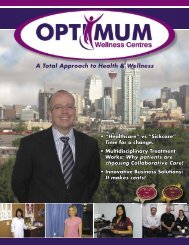CVFP Magazine 2006.indd - Paragon Publishing Inc.
CVFP Magazine 2006.indd - Paragon Publishing Inc.
CVFP Magazine 2006.indd - Paragon Publishing Inc.
- No tags were found...
You also want an ePaper? Increase the reach of your titles
YUMPU automatically turns print PDFs into web optimized ePapers that Google loves.
REVOVERING FROM AN INJURYIn my years of practice, there is a continuing theme from anumber of patients. That is “I thought it would just get better”,Many people arrive at a local physiotherapist stating this, evenafter months of pain and limited activity. My goal in this article,therefore, is to give you some insight regarding the naturalcourse of healing, and what you can do to speed it up, and slowit down.For those of you with acute injuries, tissues should heal in about6-8 weeks. If it is simply an irritation or mild sprain/strain, 2-4 weeksmay be sufficient. And even if it takes 6-8 weeks, you should noticesome improvements within 1-2 weeks. Improvement is noted,be it less pain, increased range of motion, decreased swelling, orimproved strength. If you are not experiencing an improvement,a number of factors may be contributing:A. Doing nothing - this is probably the number one factor forprolonged recovery, and prolonged pain. You are doingNOTHING. The first thing to do when recovering from an injuryis being pro-active with it. Do not let it control you or your life.Seek help from any variety of sources. A physical therapist isskilled with musculoskeletal injuries. These may vary from a wristsprain to rotator cuff problems. Your physician can aid therecovery with appropriate pharmacological intervention. Themost important part in the initial recovery is MICE; that is gentleMovement, Ice, Compression (wrap the injured area) andElevation (if swelling visible).B. The acute phase of the injury will last 4-10 days, and then immediatetreatment is indicated. Once out of the acute phase,there are a number effectors that contribute to your healing/lack there of. These include:CROWFOOTPHYSIOTHERAPY LTD.8 Crowfoot Village Family Practice1. Wrong exercises - the exercises provided may be doing someharm. If you are experiencing any pain with a particularexercise, you should make your treating professional aware ofit. They won’t change it if they don’t know. Also, the exercisemay be too advanced for the affected area.2. Poor technique - always a factor. Every exercise should bedone as taught. Even minor adjustments in technique couldbe a factor. I remember Tony Little (pretty hyper guy) yelling,“It’s Technique”... and even though it drove me nuts,he is right. Talk to your Physio if unsure on how to perform anexercise.3. Not enough of the exercises - especially with back painsufferers. Some exercises for pain control need to be donefrequently throughout the day (even every hour sometimes).Discuss with your therapist how often things need to be done,and do them.4. Still doing something which is aggravating the problem - didn’tthink this should be a problem, but it is. Patients often try topush through an activity, even though it hurts. You know, theNo Pain, No Gain thing. Sometimes this theory applies, butcertainly not for acute injuries.5. Missing an area - often overlooked are joints above andbelow the problem. Also, neck should be reviewed with armpain, and low back should be reviewed with leg pain. Hipstructures when tight or weak can affect the knee and ankle.Same goes for the upper extremity. Neck and back problemsoften refer symptoms to the arms and legs. I have seen manypeople for what they thought was tennis elbow, but was infact a disc problem in the neck.6. Wrong diagnosis - as with the tennis elbow problems, peoplehave come to me after attending treatments for tennis elbow- complete with ultrasound, frictions, and other modalities, withminimal success. Once the proper diagnosis was reached (i.e.Neck), the pain was reduced within a short period of time.7. Non-mechanical pain - this is a big one. Stuff like cancer, multiplesclerosis, and diabetes are in here, and can be picked upwith a few tests. Other things like STRESS are often overlooked.Stress seriously impedes recovery, and should not be overlooked.If stress is present, try to get rid of it. You will be amazedhow quickly progress can be made.The bottom line with any form of treatment is that you shouldhave lasting results. Not just temporary and you should noticeimprovements over time. If not, discuss it with your treating physician,physical therapist, chiropractor, or other treating professionalIf nothing is happening with your recovery, do somethingabout it. Also, the pain relief should be lasting, and injuries shouldbe preventable.The bottom line, when recovering from an injury, is that youshould be noticing improvements regularly. If not, talk to yourhealth care provider, get a test done, change treatment protocols,look elsewhere in the body, or see someone new. Sometimesa new set of eyes can make a difference. And most importantly,take charge and prevent this from happening again.Tim KutashPhysical TherapistCROWFOOT PHYSIOTHERAPY and MASSAGE










